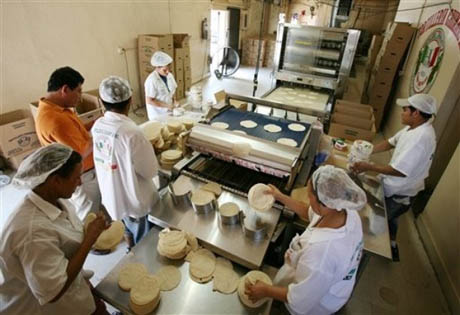Three short stories of food and the city:
1. An analysis of food remains at three sites in Lower Manhattan showed that the kinds of fish eighteenth-century New Yorkers ate changed significantly over time: social archaeologist Nan Rothschild found that “early New Yorkers consumed sheepshead (71% of all fish bones), with striped bass second (24%). By 1760, only 4% of the fish bones came from sheepshead, and a bit more from striped bass; the new leaders were sea bass and scup.”
Rothschild speculates that the reason for the disappearance of sheepshead and the triumph of scup is linked directly to the city’s physical growth. Apparently, while “sheepshead live close to shore, preferring uneven bottom surfaces,” scup prefer “smooth river bottoms,” which means that as New Yorkers reshaped the topography of their riverbeds with landfill, they were inadvertently redesigning their diets as well.
2.
IMAGE: Workers at Tortilleria Chinantla, which produces about one million tortillas daily and controls sixty percent of New York City’s restaurant, supermarket, and bodega business according to its owner, trained architect Erasmo Ponce. Chinantla is one of six tortillerias in Brooklyn’s Tortilla Triangle, one of the relatively few food manufacturing hubs that remain in New York City. As this New York Times article explains, “Tortillerias can work well as local businesses, because freshness is important to consumers and because the manufacturers’ profit margin is thin enough – 30 tortillas sell for about $1 in New York – that reduced distribution costs provide an edge.” (Photo via AP)
3. In 2001, Steve Ross of Coney Island Bialys & Bagels was invited to demonstrate traditional bagel making at the Smithsonian Folklife Festival in Washington D.C. Everything was going fine, until he gave the last of the thirty gallons of New York City water he had brought with him to Herman Vargas of Russ & Daughters, who was demonstrating authentic New York pickle-making next door.
“We tried to make a few bagels and bialys with Washington water and we couldn’t get a rise out of the dough,” reported Steve. Only the intervention of the NYC Department of Environmental Protection, which airlifted in twenty gallons of the finest city tap water, averted a “mediocre bread roll with a hole in the middle” disaster.
•••
These stories, and many more, all come from the pages of Gastropolis, a collection of essays about food and New York City, and the starting point for a free panel discussion of the same name at Brooklyn Library tomorrow. The book’s co-editors, Annie Hauck-Lawson and Jonathan Deutsch, as well three of its chapter authors, Jessica B. Harris, Mark Russ Federman, and Annie Lanzillotto, will be participating in a conversation about the ways in which food communicates different aspects of New Yorkers’ personal, social, and ethnographic identities. The Gastropolis panel will start at 1:30 p.m. at the Central Library on Grand Army Plaza: more details and directions are available here, and all are welcome!


Great stories, but I really don’t know how much to believe the bagel story. sure it suits NYers to think that, but honestly, how crucial do you think the water composition is? My bubba always used to make them with potato water, and I can’t say I’ve ever had better bagels, but I taste those through the haze of childhood.